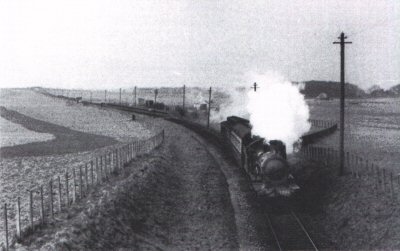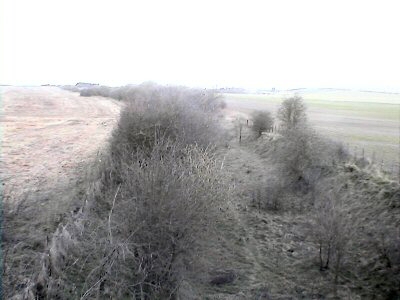The Didcot, Newbury & Southampton Railway (DNSR) received its Act for construction on 5th August 1873. The Didcot-Newbury section came into use on 13th April 1882, followed by the Newbury-Winchester part on 1st May 1885. Financial difficulties prevented the planned route to Southampton being completed and the company had to use existing lines from Winchester. The DNSR was absorbed into the Great Western Railway (GWR) in 1923, but heavy freight traffic was sent by less steeply graded routes. During World War II these routes were congested on many occasions and it was decided to double much of the DNSR and the line was closed to through traffic during the daytime from 4th August 1942 to 8th March 1943 to speed up the work. Provision had already been made in all the structures for double track at the time of building.
The line became an essential link between the armament and military equipment suppliers of the Midlands and the South Coast ports before and after the invasion of Europe. Prior to D-Day 16,000 military trains were operated over the line.
The section south of Newbury was closed to passengers on 7th March 1960 and the northern section closed on 10th September 1962. Through freight traffic continued until 9th August 1964.
Churn Station was provided in June 1888 for the benefit of the National Rifle Association, who had a rifle range nearby (N51º 32.468' W001º 15.108'), and it was used subsequently by many annual military camps. There was no road access and trains did not call after dark. The timetables stated "Stops to take up or set down on previous notice being given to the Station Master at Didcot. Evening trains call during daylight only." Trains were timetabled to take 14 minutes to arrive after departing Didcot.

Looking northwest towards Churn Station in 1937.
The cache is placed close to the original island platform of Churn Station which had no buildings apart from a wooden shelter and a urinal. I recommend accessing it from the more southern of the two railway bridges you can find here (N51º 32.249' W001º 15.180'). How you get to this bridge is entirely up to you! It is on The Ridgeway so you could approach it from Compton or East Ilsley. If you are driving you can park your car at the end of Boham's Road at N51º 32.784' W001º 15.955. You could also park closer at N51º 32.578' W001º 15.418' but this road is not officially a public right of way and be aware that there is no easy turning (unless you have a suitable vehicle) beyond this point. On your way up Boham's Road from Blewbury consider the gradient of the road. You can then understand why double-headed giant American trains were required to pull the massive military trains up the 1 in 106 gradient from Upton & Blewbury Station.

Looking northwest towards Churn Station in 2004
The walk to the cache can be muddy and please be careful as there is a steep descent from the bridge to the trackbed.
The cache itself is a 10x5" (25x13cm) metal box containing various goodies.
Evidence for the railway is in abundance in the area, the original station building at Upton is visible, now a private residence. The huge embankment which carried the railway from Didcot is visible, and until very recently the large embankment which took the line over the Broadway in Didcot was in place, it was recently demolished to build the new link road.
If you enjoy bird watching the Oxford Ornithologial Society have a guide for the area around the station available here.